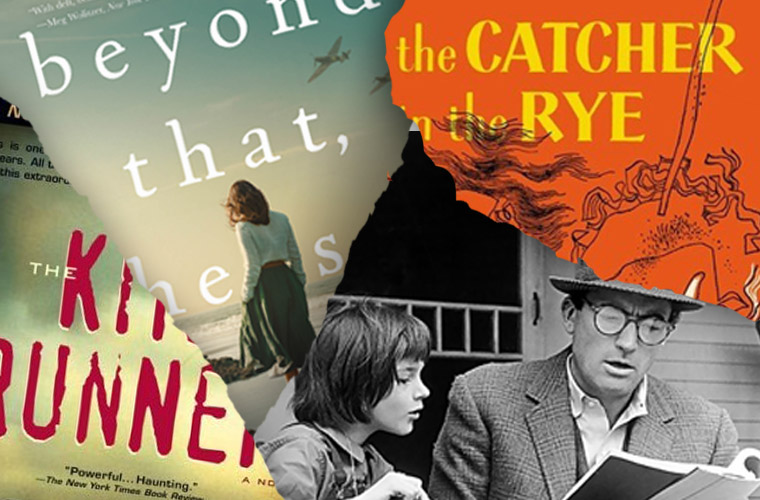Whether you long for the carefree days of childhood or cringe when you think of the angsty poetry you wrote as a teen, we all recall the process of growing up. Those messy years of heartache, happiness, and self-discovery are seared into our brains — it’s no wonder an entire literary genre exists to explore them.
The genre, of course, is the bildungsroman, also known as the coming-of-age story. But identifying its key characteristics can be tricky. What exactly is a bildungsroman, and how is it related to the coming-of-age story? We’re turning back the clock to delve into this beloved genre, from foundational texts by Goethe and Dickens to sweeping new narratives like Laura Spence Ash’s historical coming-of-age novel Beyond That, the Sea.
Definition of Bildungsroman
“Bildungsroman” is German for “novel of education” or “novel of formation,” and it is a story that traces the moral and psychological growth of its protagonist over time. Change is key to the bildungsroman; as time passes, its naive protagonist matures into a more emotionally, psychologically, or spiritually sophisticated individual.
A typical bildungsroman doesn’t just follow a protagonist from childhood into adulthood, however. More specifically, it explores the life lessons that a protagonist learns as they reckon with the wider world around them — making the narrative a “novel of education.” Often the protagonist is set in a conflict at the beginning of the book, a personal loss in their childhood, perhaps, or disillusionment with the way society works. The narrative then traces the protagonist on an arduous physical or psychological journey as they grapple with moral quandaries, gain invaluable life experiences, and after great difficulty, reach a higher state of understanding about themselves and their pace in society. By the end of the narrative, the protagonist has grown significantly, showing far more depth and maturity than they did at the novel’s start.
Many classic examples of the bildungsroman, such as Jane Austen’s Emma or Charles Dickens’s David Copperfield, include the protagonist’s name in the title, signaling from the outset that the book you’re about to read is entirely about the character and their journey through life.
The Origins of Bildungsroman
Many literary scholars point to Johann Wolfgang von Goethe’s Wilhelm Meister’s Apprenticeship (1795–96) as the first major published work to lay the groundwork of the bildungsroman. Christoph Martin Wieland’s Geschichte des Agathon (1766–67) is also cited as a foundational text. In Goethe’s novel, readers follow a disillusioned young businessman who sets out on a quest of self-discovery, searching for a life of fulfillment and purpose. When Wilhelm Meister’s Apprenticeship was translated into English in 1824, the novel exploded in popularity and attracted a wide readership, likely influencing British novelists like Charles Dickens and Charlotte Brontë, and later inspiring American authors such as J.D. Salinger and Harper Lee.
The term “bildungsroman” is said to have been coined in 1819 by the language scholar Johann Karl Simon Morgenstern. Morgenstern was inspired to pen the phrase after a critique from a former teacher, who lamented that Morgenstern’s writing had grown increasingly vain and boring the more he reflected on art, literature, and philosophy. Unsurprisingly, this critique mirrors the charge of navel-gazing that is sometimes lobbed at coming-of-age stories — likely by those who have forgotten what it’s like to be wide-eyed and eager to learn more about the world!
While early examples of the bildungsroman tended to conclude on a happy note, in the 20th and 21st centuries, stories just as often ended in frustration, resignation, or death. Here are just a few examples of the bildungsroman, from classic texts to modern-day works:
Examples of Bildungsroman
- Great Expectations (1861) by Charles Dickens: In this look at class in 19th-century England, young Pip goes from impoverished orphan to gentleman after being given money by an anonymous benefactor. As he moves up in the world, he comes to learn that external rewards shouldn’t distract from one’s inner conscience.
- The Adventures of Huckleberry Finn (1884) by Mark Twain: Huck Finn, a teenager escaping the constraints of society, and Jim, who is escaping from slavery, embark on a journey west in search of material, physical, and personal freedom.
- A Portrait of an Artist as a Young Man (1916) by James Joyce: This landmark novel is an example of a Künstlerroman, which is an offshoot of the bildungsroman that traces the growth and maturation of a young artist. Joyce’s “artist’s novel” follows young Stephen Dedalus as he reckons with the religious and societal strictures of Catholic Ireland. One way in which a Künstlerroman differs from a bildungsroman is in its ending: Often the artist protagonist rejects society rather than accepting their place within it (no spoilers!).
- The Catcher in the Rye (1951) by J.D. Salinger: Probably the most famous story of teenage angst, the book is narrated by recently expelled boarding school student Holden Caulfield. A jaded teenager, he starts the novel hating everyone and everything. Though the book only covers a weekend, Holden embarks on a transformative emotional and philosophical journey from angst to optimism about the future.
- To Kill a Mockingbird (1960) by Harper Lee: Young Scout learns about hate in her community when her lawyer father defends Tom Robinson, a Black man accused of a crime he didn’t commit. Throughout the novel, Scout witnesses the consequences of her community’s insidious bigotry.
- The Kite Runner (2003) by Khaled Hosseini: This bestselling tale of two friends from different social classes follows their complex friendship as they come of age during a tumultuous era in Afghanistan.
What’s the Difference Between a Bildungsroman and a Coming-of-Age Story?
The terms bildungsroman and coming-of-age story are often used interchangeably. And yet, the bildungsroman is a distinct type of coming-of-age literature that follows formal and thematic guidelines on structure, plot, and point of view. The coming-of-age story, by contrast, is a broader term that applies to an array of formative narratives, many of which do not adhere to the strict template of the bildungsroman. In other words, you can call every bildungsroman a coming-of-age story, but not every coming-of-age story is a bildungsroman.
A coming-of-age book chronicles the development of a young protagonist as they navigate the world and their identity, reaching a deeper understanding of who they are and where their life is headed by the end of the narrative. Because it’s a catch-all term, the coming-of-age narrative can be found across the literary spectrum, from coming-of-age graphic novels and speculative fiction tales to autobiographies and memoirs, like Patti Smith’s Just Kids or Mikel Jollett’s Hollywood Park.
A new narrative that shows how creatively authors are approaching the coming-of-age tale beyond the confines of the classic bildungsroman is Lauren Spence-Ash’s debut novel, Beyond That, the Sea. It’s not told from a single, first-person perspective; rather, readers witness protagonist Beatrix Thompson navigate childhood to adulthood through not only her perspective but also the points of view of those around her. Beginning in WWII and stretching all the way into the 1970s, the historical fiction tale explores a timeless coming-of-age conundrum: How do you form your identity when your sense of home and family is in flux?
The story starts in London as young Bea’s parents send her to live with a wealthy family in Boston as part of a wartime program that shepherds British children to safety. Just as Bea begins to find her place in America with her surrogate family, the war ends, and she’s called back to England. The novel follows her growth as she struggles to navigate love, loss, home, family, and identity. This, of course, is why we love coming-of-age tales: They help us to work through our own process of becoming who we are, whether we’re going through it right now or went through it a half-century ago.
Examples of Coming-of-Age Novels
- Little Women (1868–69) by Louisa May Alcott: The story follows the lives of the four March sisters — Meg, Jo, Beth, and Amy — and details their passage from childhood to womanhood.
- The Giver (1993) by Lois Lowry: This dystopian novel follows young Jonas as he realizes that the society in which he lives — which is free from pain, suffering, and choice — is a society that has no true love or joy. In order to escape, he must take everything he’s learned about the forgotten past and seek what lies beyond the confines of his town.
- Persepolis (2000) by Marjane Satrapi: This autobiographical graphic novel recounts the author’s childhood and early adult years in both Iran and Austria during the Islamic Revolution. Like Beyond That, the Sea, the main character deals with finding a home between two countries in the midst of a devastating war.
- The Curious Incident of the Dog in the Night-Time (2004) by Mark Haddon: This coming-of-age tale follows Christopher, a neurodivergent youngster who plays detective in the death of his neighbor’s dog. As he investigates, our hero learns truths about his family and realizes that even our beloved parents have flaws.
- The Hate U Give (2017) by Angie Thomas: High school student Starr Carter narrates the increasing disconnect she feels between the predominantly white prep school she attends and her home, family, and friends in Garden Heights, a fictional working-class Black neighborhood. This disconnect is brought to a head when a cop kills her friend Khalil in front of her and she must find the strength to both march and testify against police brutality.
------------------
The coming-of-age tale is popular among young readers, who see in these stories their own journey of maturation and self-discovery. But even those of us well past our teenage years will find something to love in a powerful story of personal growth and transformation.




